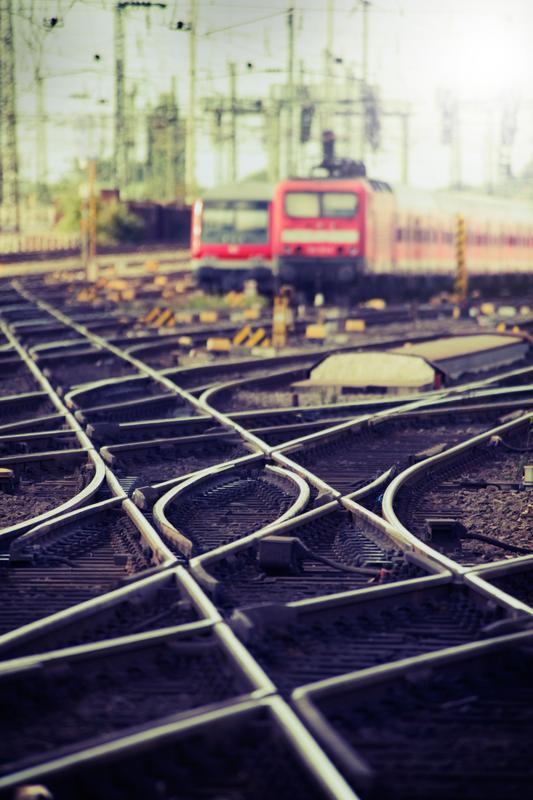Invention that can be easily retrofitted makes railway traffic safer

A newly developed simple device helps in better locating trains on the rail network.
Train location systems traditionally work with track current circuits or loops, which make use of the short circuit established between the rails and the train’s axles. The electric current can however be disturbed by dirt or corrosion on the contact surfaces. The solution to this problem developed at the Offenburg University of Applied Sciences is now ready for testing under real life conditions.
One of the central requirements in railway traffic is to always know whether a track segment is free or occupied by a train. Precise and robust localization of trains is essential to prevent serious accidents. At the same time, it allows a higher train frequency and thus a better use of the rail capacity. The more precise the localization of the trains, the shorter the distance between trains can be.
The process developed at the Offenburg University of Applied Sciences allows a more reliable determination of the track usage. Until now the position of trains was mostly determined by so-called track current loops. The steel wheels and axles of a train generate appropriate signals by means of the short circuit created between the two rails.
The layer of rust and dirt that develops on the rails over time represents a problem for this process. Furthermore, problems are encountered when locomotives are used across national borders because the wheels, due to the different profiles used in different countries, may not be touching the rail track head in a position, where the rail is kept clean through constant usage.
Professor Peter Hildenbrand of the Faculty of Electrical Engineering and Information Technology, Offenburg University of Applied Sciences, developed an innovative solution to this issue.
The new process achieves the necessary voltage drop which acts as signal for the control system by creating sparks which are capable of penetrating potentially isolating dirt layers. The device which creates the sparks (electrodes, control, power supply etc.) is mounted on the railway carriage.
Implementing the present invention allows the continued use of the widely implemented track current loops without the need for any modifications. There is no need to make costly changes to the track network, as is the case with inductive track monitoring systems, nor is there a need for substantial investments as is the case with GPS based systems. In the latter case, the reception depends on weather conditions, tunnels and stations and therefore necessitates costly supplementary solutions.
The costs associated with this robust and reliable system are very low and the retro-fitting of older railway stock is simple. The design is uncomplicated so that trains and carriages can be retrofitted easily. The component parts of the system are robust and already proven in other applications, for example the car industry. In addition, the device is independent of the electricity network. Electricity is being supplied by batteries and thus the system remains operational even when the train is stationary and there is no power supply.
In a more integrated Europe with increased rail traffic across national borders, the fact that locomotives do not have to be changed at the border represents an enormous time and cost saving. For this reason, TLB was keen to seek patent protection not only in Germany but also in France and Great Britain.
TLB assists the Offenburg University of Applied Sciences in the commercialisation and marketing of the invention and currently seeks jointly with the inventor, Professor Hildenbrand, collaborators for the further development and licensees to test the system under real life conditions. Rail carriage manufacturers and enterprises involved in railway signaling technology are seen as likely candidates for such a collaboration.
The Offenburg University of Applied Sciences, which owns the rights to this invention, has charged the Technologie-Lizenz-Büro der Baden-Württembergischen Hochschulen (TLB) GmbH in Karlsruhe with the management of the patent rights and the commercialisation of the invention. TLB is now looking for suitable commercial partners and/or licensees and supports the university in the commercialisation and marketing of the innovation.
Further information is available by contacting Mr Emmerich Somlo Dipl. Ing., TLB-Innovations Manager on telephone +49 721 790 040 or via email esomlo@tlb.de
http://www.technologie-lizenz-buero.com
http://www.hs-offenburg.de/en/
Media Contact
All latest news from the category: Transportation and Logistics
This field deals with all spatial and time-related activities involved in bridging the gap between goods and people, including their restructuring. This begins with the supplier and follows each stage of the operational value chain to product delivery and concludes with product disposal and recycling.
innovations-report provides informative reports and articles on such topics as traffic telematics, toll collection, traffic management systems, route planning, high-speed rail (Transrapid), traffic infrastructures, air safety, transport technologies, transport logistics, production logistics and mobility.
Newest articles

Parallel Paths: Understanding Malaria Resistance in Chimpanzees and Humans
The closest relatives of humans adapt genetically to habitats and infections Survival of the Fittest: Genetic Adaptations Uncovered in Chimpanzees Görlitz, 10.01.2025. Chimpanzees have genetic adaptations that help them survive…

You are What You Eat—Stanford Study Links Fiber to Anti-Cancer Gene Modulation
The Fiber Gap: A Growing Concern in American Diets Fiber is well known to be an important part of a healthy diet, yet less than 10% of Americans eat the minimum recommended…

Trust Your Gut—RNA-Protein Discovery for Better Immunity
HIRI researchers uncover control mechanisms of polysaccharide utilization in Bacteroides thetaiotaomicron. Researchers at the Helmholtz Institute for RNA-based Infection Research (HIRI) and the Julius-Maximilians-Universität (JMU) in Würzburg have identified a…



